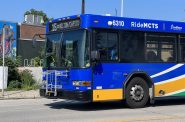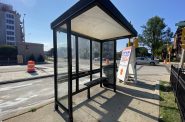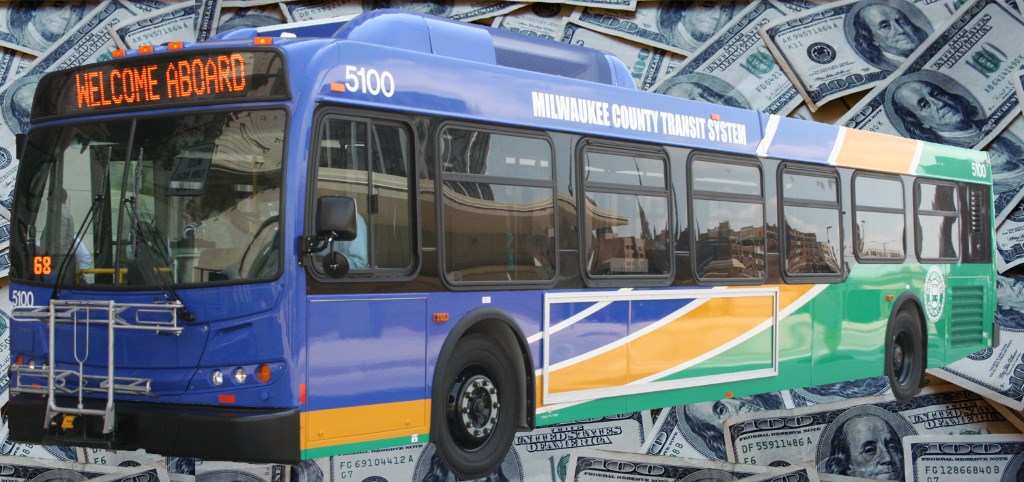Chris Abele Unveils Plan to Save Transportation
Annual fee would provide $27 million for county transit and roads. One supervisor already opposed.
Flanked by mass transit advocates, Milwaukee County Executive Chris Abele unveiled his “SAVE Transit” plan in a press conference this afternoon. After five budgets without personally introducing a levy increase, the county executive unveiled a plan to provide a “dedicated funding source” for the Milwaukee County Transit System, as well as the county’s highways, parkways and bridges. The plan would be funded by a $60 addition to the annual vehicle registration fee car paid by vehicle owners in Milwaukee County that would fund $27 million in annual county transportation improvements.
The increase would raise the total vehicle registration fee to $155 for city residents, with $75 going to the state and $20 going to the City of Milwaukee. Suburban county residents would pay $135 per vehicle under the proposal. As Abele repeatedly hammered home during the press conference, there is “no way to avoid it,” the county needs more money for transportation. Since Abele’s predecessor Scott Walker became governor, the state has reduced support for mass transit. Abele notes that since he has been in office, “the state has paid less and the county has paid more.” The county has avoided raising fares or cutting routes by using one-time federal grants to support the system, but most of those grants have or will shortly be exhausted.
Even after factoring in the increase, which would bring the total to $155, Abele notes the total is “still less than most Midwestern cities.” A chart on display at the press conference showed the annual fees less than Chicago, Minneapolis, St. Paul and Indianapolis.
Milwaukee County, and other municipalities, are severely restricted in their ability to raise funds to support transportation. Unlike cities in many other states, Wisconsin counties and municipalities cannot create an additional sales tax without a state law change. This has created the unusual setup where the Milwaukee County Transit System is heavily reliant on state aid (45 percent of the MCTS budget) with farebox revenue (29%), federal aid (16%) and the county property tax levy (10%) making up the rest. The vehicle registration fee, commonly called a “wheel tax,” is one of the only fees a county can raise to generate additional revenue. Answering a follow-up question during the press conference, Abele stated that “he would like something that is more progressive” for the fee breakdown, perhaps by vehicle type, but that the current state law only allows a blanket approach.
When questioned on the likelihood of the county board supporting the proposal, the county executive declined to play oddsmaker, but noted that the board understands the issue and shares the desire to provide quality services to county residents. Milwaukee County board chair Theodore Lipscomb, Sr. did not return a request for comment by the time of publication.
Specific details on the funding breakdown for the plan were not available at the time of publication. We are awaiting a formal press release from the county executive. [UPDATE 3:35 p.m.: A press release has been issued by the executive that includes a few more details on plan specifics not available at the press conference.]
The County Board Responds
UPDATE #2 (4:36 p.m.) – Supervisor Michael Mayo, Sr. who chairs the county’s Transportation, Public Works and Transit Committee and has been a long-time proponent of dedicated funding via a sales tax, reached out in opposition to Abele’s proposal. Mayo emphatically stated “I am not in favor of a wheel tax.” The long-time supervisor noted that Abele’s move was a “flip flop” that would end up as a “double whammy” to Mayo’s constituents, who would see their registration fees rise 63% and still have to pay the state and city vehicle registration fees. Mayo claims Abele is “hurting more people than he’s helping.”
What about the fact that the state legislature would be required to approve a sales tax? “He runs to the state about everything else and they approve it, why not now? Why not just try? Dedicated funding will save our transit system, not a wheel tax.” Mayo’s suggestion that the county executive should look to the state legislature for help comes after Abele has successfully negotiated with the state for the arena deal and legislation that limited the authority of county supervisors and made their positions part-time.
What’s Next?
The county executive will include the plan as part of his 2017 budget proposal that will be reviewed tomorrow. The Milwaukee County Board of Supervisors, which includes a number of newly elected supervisors, will then begin the process of reviewing the budget. The board will return an amended version of the budget to the county executive in November, who then may veto or approve specific provisions. The board then has the right to vote to override any vetoes made by the county executive before the budget becomes law.
A potentially controversial part of the proposal, at least between the board and executive, are the modifications to the GO Pass. The pass, which grants free rides to seniors and those with disabilities, would be amended as part of the budget proposal. Pass holders would pay a $5 fee to obtain the card, and then be required to pay 25 cents per ride. The pass, created by the board, has cost $12 million over three years according to Abele.
Via press release, Abele notes “eligibility for the GO Pass will now be in line with eligibility for other government programs. To qualify for the GO Pass, seniors and individuals with disabilities must also be eligible for SSI, SSDI, EBD, or FoodShares. Administration of the GO Pass will shift from MCTS to the Aging and Disability Resource Centers. We believe that this change may also come with an added benefit – by bringing more people into the resource centers, more people may enroll in other programs for which they qualify. The county executive also plans to establish a committee of stakeholders that will determine the best way to implement these changes.”
Eyes on Milwaukee
-
Church, Cupid Partner On Affordable Housing
 Dec 4th, 2023 by Jeramey Jannene
Dec 4th, 2023 by Jeramey Jannene
-
Downtown Building Sells For Nearly Twice Its Assessed Value
 Nov 12th, 2023 by Jeramey Jannene
Nov 12th, 2023 by Jeramey Jannene
-
Immigration Office Moving To 310W Building
 Oct 25th, 2023 by Jeramey Jannene
Oct 25th, 2023 by Jeramey Jannene
Transportation
-
MCTS Adds 28 New Buses
 Jul 13th, 2024 by Graham Kilmer
Jul 13th, 2024 by Graham Kilmer
-
MCTS Designing New Bus Shelters
 Jul 10th, 2024 by Graham Kilmer
Jul 10th, 2024 by Graham Kilmer
-
MCTS Updates RNC Bus Detours To Better Serve Downtown, Riders
 Jul 9th, 2024 by Jeramey Jannene
Jul 9th, 2024 by Jeramey Jannene























The progressives must be wetting their pants. We get to give more money to government! Hallelujah! One step closer to a perfect world.
I be more in favor of it if they’d (also) work with / lobby the state to re-instate the ability to run a regional transit administration and we’d get some real visionary developments out of it.
Abele did it. He bought his top floor condo looking over the new Bucks arena that we paid for. So what do we get? We get the Milwaukee Bucks President calling the County a bunch of racists. Abele has no money in his budgets to pay for buses or roads. He won’t use tools in his budget to ask for shared responsibility on matters of pension and heath care reform with his employees. Instead, he blames the State. The County board that Abele has to arm wrestle with creates a new entitlement for bus passengers. 1 in 4 passengers are essentially dead beats. Working families have the burden of paying for free bus rides, golf, fish farms, and the high school kid working the dish washer at the county zoo now makes $ 15 hour. Nice job Abele.
Jason why are you here? What with Abele being so terrible and so many deadbeats using public transportation (the audacity!) and everything being just so awful, why not move? Are you like 80 or something? You sure talk like a cranky old man.
The buses are packed with deadbeats going to and from work daily. I have witnessed these bums for years, sitting in my seat at the front of the very same buses, day in, day out for decades. Jason, what can we do about these deadbeat bus riders? Perhaps start by defining “deadbeat.”
Yes, Vince I am the ghost of Milwaukee County’s past. When only half the budget was dedicated to workers salaries and benefits.A time when the County actually could function. Where the County could actually build a structure like the domes, and county buses were paid for from the actual budget, a time when people actually paid to ride the bus. A time when local politicians did not always roll over to its public employees. A time when politicians did not dream up silly ideas like changing Red Arrow park to Dontre Hamilton Park or light rail. A time when tax payers could actually see their hard work being put to use.
Jason. You sound like a dumb Donald Trump. That’s saying a lot.
Mr Horne, I am not sure you realized but all these free rides added another $4 million dollars to the transit budget each year. What happened ? Did we just decide that 1 in 4 transit riders could not come up with a $2.00 fare. The hardship they must have been going through for all those years. So, now we just stick it to working mom or dad. God forbid they drive a Cross over to take their kids to school or soccer. Yah, there good for it. Then when they decide to move to Brookfield or Racine County well then their racists. Just another middle finger to working families that happen to not be using your preferred public transportation.
Jason, do your research as we must do here at Urban Milwaukee. The reporting of Jeramey Jannene was the first to detail the financial problems with the free fares. No publication has been more thorough or accurate on the topic. Start with facts or keep your opinions to yourself.
Mr .Horne no where in your comment did you state my error. Also, almost every one on this site expresses their opinions. Maybe you need to except more diverse opinions. P.S…..thank you for your articles and your research.
Jason you keep setting new lows for indecency and awfulness. Support the officer all you want but Dontre Hamilton was a human being with a mental health issue who is now dead. Your glib comment is cruel. Maybe offline you are a nice guy but you sure seem like a terrible person.
No one is suggesting everything is perfect. Nearly every person here who comments regularly has complains and concerns. But you are nothing but doom and gloom. You only see negative and only Democrats are to blame. You mock and belittle and heap scorn on everything. Saying you have a closed mind is the understatement of the century. Diverse opinions are great but Horne is right. You never say anything remotely productive.
Jason, if you want your factual errors pointed out (post 10), here are two you made in post 8.
• The bus fare isn’t $2.00. For these people (anybody eligible for Go Pass), the fare was $1.10. And even for others (those ineligible for Go Pass), there is no $2.00 fare—it is either $2.25 (cash) or $1.75 (M-Card).
• Go Pass use hasn’t increased the transit budget by $4 million. You seem to mis-understand the meaning of “budget”. A “budget” is an estimate of expenses and revenue in a month, year, etc. And Go Pass use has neither increased neither transit’s revenue nor its expenses. You would have been correct if you said Go Pass increased the budget shortfall, but you didn’t (because you don’t seem to understand the difference).
This is not a wheel tax to “SAVE” mass transit. I support paying for mass transit, but this plan is not about saving mass transit and goes too far and affects people who can least afford it. I have a number of issues with this plan.
First, the count doesn’t need $60 million to save mass transit. By their own numbers $27 is all that’s needed.
I think the BRT is a good idea, but if we’re trying to “save” the mass transit system can we really afford it just yet?
The VRF is the worst way to go about this. It hits the people who can least afford to own a car… it will increase the number of people driving without registrations. This will undoubtedly result in more people stopped and ticketed for unregistered vehicle and they’ll get a ticket that they also can’t afford. With two cars, my household will see a $110 year increase… I’d rather pay more on my property taxes because I can afford it than raise the wheel tax on many people who can’t. IF the spending is responsible… which it doesn’t appear to be.
They need to eliminate the GO Pass! This has caused, by their own numbers, a $12 million deficit in three years! The changes to the program they propose are too small of a step.
They should only raise enough money to raise the minimum amount needed for the program. This is a major problem in government. They don’t keep things efficient and at a minimal level to meet the needs… instead they create an extra slush fund for other projects.
Finally, if they are so desperate for money, why do they think a $15 minimum wage for county employees and county contractor employees is a good idea right now? There are many people who live in the county that need a car to get to their job, if they can no longer afford it then we’re going to force them to lose their job. Does raising the wages for some justify others losing their jobs?
Raising more funds if truely needed is fine… and I’m willing to pay more myself because I can afford it. Unfortunately, the county is again showing how irresponsible with taxpayer money they are. I’m not willing to pay extra unneeded funds.
AG I’m forced to concede that you make valid points. GO Pass seems like it needs to go. City residents would pay $20 more than people who live in the suburbs? That seems like it should be reversed. $60 is a lot of money for most people. That’s a steep increase. Any chance Abele did this knowing it’s never going to fly?
AG (post 13),
Once built (using mostly federal money), the BRT would probably cost less than the existing bus service on that route. That’s what happened in Cleveland.
Faster buses are cheaper buses; a 10% reduction in travel time results in 10% fewer buses used (to provide a given frequency) which results in a nearly 10% reduction in both operating and capital costs. (Very few transit costs—mostly fuel and tires—are mileage-dependent, and those costs are comparatively small. In 2013, for example, MCTS fuel costs were under 10% of total operating costs.)
Alternatively, a 10% reduction in trip time combined with the same number of buses used would allow 11% more buses per hour with only a minuscule increase (perhaps 1%) in costs.
And in a third alternative, faster trip times would allow a smaller combination of bothbenefits—reduced costs and more frequent service. For example, the same 10% trip time reduction would allow a 5% frequency improvement and 5% lower costs (by using 5.3% fewer buses).
Finally, faster (and more frequent) buses are more attractive to passengers, so reduced trip times will increase the number of paying passengers, which will reduce the taxpayer subsidies needed.
Unfortunately, even such a steep increase in the wheel tax will not make any groundbreaking changes to transit in Milwaukee County.
Part of the money will go to roads. After patching/rebuilding our county’s most dilapidated roads, that money will be gone. No net change other than a smoother ride for the time being, until the roads fall apart again. One wishes that such a large fee increase would only be necessary if we were building something new, not routine maintenance.
The other part will go to mass transit. Instead of revamping our route structure, introducing a more efficient form of transit, building dedicated bus lanes for our most used routes, we will simply be replacing old worn out buses and building a BRT line to a hospital in Wauwatosa. Don’t get me wrong, I like the idea of BRT, I just wish that a 50% registration fee increase could come at a time when we have people with a vision running the county and MCTS. The system is so habitually underfunded that even a massive fee increase will mostly be spent on shoring up expenses that should have been paid for already. The net improvements to the system for any end user are minimal.
Such is life in a conservative state where nobody wants to fund transit. It’s funny to see people complain about our infrastructure, then complain again when someone wants to pay for it. Anyone who doesn’t want to pay for the basic necessities of an urban metro area should just leave Milwaukee County already.
I agree Joe. Those are some good points. But doesn’t a $60 increase at the annual VRF hurt city residents?
Vincent, a $60 VRF only “hurts” city residents if you think every penny paid in taxes and fees “hurts” them. Building, maintaining and improving infrastructure in an urban metro area costs money. You can either watch it crumble and have transit that doesn’t work for anyone, or have functional roads and build a competent transit system. I’d gladly pay more in taxes for the latter, but it seems most in this County would prefer the former.
I think the cost of today’s Go Pass is misunderstood.
If all of today’s Go Pass riders simply stopped riding the buses, the County would save virtually nothing—since buses with empty seats cost pretty much the same as fuller buses to buy, operate, and maintain.
If, on the other hand, all of today’s Go Pass riders continued riding but paid the regular $1.10 reduced fare, the County would take in far more than what Go Pass costs today. But that wouldn’t happen; charging $1.10 would cause most of those riders to disappear (and, remember, losing those riders saves the County virtually nothing).
Abele’s suggestion of charging 25¢ might be part of the solution. That 25¢ more than covers the marginal expense of each rider. It might even bring in more fare revenue than just re-instating the $1.10 fare, especially if Go Pass were disallowed at rush hour when bus capacity is an issue.
One other aspect of Abele’s proposal seems to have flown under the radar. He proposes expanding Go Pass beyond today’s elderly and disabled to also include the poor of any age. He proposes expanding eligibility to anybody getting either SSI, “Food Share” (which I assume is food stamps), or EBD (what’s that?).
The cost of expanding Go Pass to the poor (even with a 25¢ fare) seems like a much larger budget hit than today’s program. While it’s an interesting idea, I think it might require a huge additional subsidy.
OK let me rephrase. Is raising that fee by $60 the best approach here?
I think a combination of more funding from the state DOT budget and an increased VRF would be the best approach. We all know the likelihood of that is, so Abele is doing the only thing he can.
Considering that actually fixing all of our crumbling roads and building a competent transit system would cost billions more than the paltry $27MM this will produce, if anything the VRF should be increased even more.
Tom D., where is your proof that “most GO Pass riders would stop riding” if you charged them $1.10 per ride? It is well-documented that paying half-fare was not a significant issue for the seniors in this County prior to implementation of the GO Pass.
Of course with any fare-based system there will be ridership dropoff as fares increase. I’m curious where you get your numbers from in concluding that “most” GO Pass users would choose not to ride the bus as opposed to paying $1.10.
I forgot one point in my previous post (#19) about Go Pass—the disastrous effect of even a small portion of today’s Go Pass riders switching to Transit Plus.
Transit Plus is MCTS’s “demand-response” service for those who are too disabled to use regular buses. Transit Plus costs taxpayers far more than regular bus service. In 2014, for example, each Transit Plus trip was subsidized an average of $24.90 vs $2.21 for a bus trip.
But it gets much worse when you look at marginal subsidies—the taxpayer-incurred subsidies that come from each additional rider. For a Go Pass rider, the marginal subsidy approaches zero (while for a cash-paying passenger the marginal subsidy is actually negative—because the fare money reduces total subsidy).
On the other hand, the marginal subsidy for each Transit Plus ride exceeds $20, since each ride is “cooked to order”—each new passenger causes a new vehicle trip (often a round trip with one way empty).
In theory, Transit Plus is only for people who can’t ride a regular bus, but in practice many consider Transit Plus as something for any senior citizen.
To protect the taxpayers, the County should do everything possible to encourage marginally disabled people to choose buses over Transit Plus.
Tom D, marginal cost benefits of faster bus routes and reducing Transit Plus (even though they should control so it is only used by those who can’t use a bus) is great, but what is the bottom line? How many people are actually going to stop using the bus or on the flip side how many would once again pay the reduced fare?
We already know the answer for the GO Pass… instituting that program cost the county $12 million dollars over three years.
Now, regarding GO Pass, if your argument is that it will save us money, then please give us some hard numbers. Show us that shows the BRT will save us money instead and that it would be a better idea to do it now to start saving vs putting it on hold until we can afford it or find a better funding source. If you can’t, don’t play the cost savings argument. I generally support the BRT, but I’m not going to claim I support it because it saves tax payers money.
Joe (post 22), I think I was wrong. It appears I based my post on a “fact” put forward by Jason—who, as we know, has little or no credibility.
Jason said that 25% of MCTS passengers used Go Pass (which would be an extraordinarily high proportion for senior/handicapped riders). I picked up that “fact” as I read the article and responses and ran with it. I had assumed that since nobody had disputed his “fact” that it was correct. I should have noticed that Jason posted it, but didn’t.
My bad!
Sorry.
However, that said, I would expect a lot of today’s Go Pass rides (perhaps 25%) to disappear if the fare reverted to $1.10 based on what other cities have experienced.
http://publictransport.about.com/od/Transit_Funding/a/What-Would-Happen-If-Transit-Were-Free.htm
Sorry, last paragraph was only about BRT, not Go Pass… and please forgive other typos as well.
Tom D. (25): No need to apologize. I thought perhaps there was some literature out there on this. I agree with you that some GO Pass riders would be deterred by a $1.10 fare. I think the best way to go about it would be to keep it in place but to tie eligibility to some commonly used income threshold. By allowing GO Pass for the actually poor, i think the number of people deterred from ridership by a bus fare would be dramatically reduced.
AG (post 24):
Let me ask you, how would BRT cost more than regular buses (once you get beyond the startup costs—most of which are borne by Washington)?
And don’t you agree that faster buses cost less to operate (at a given frequency)?
My guess, though, is that if Abele’s new registration tax gets approved, the BRT proposal will fade away. I think the BRT was mostly an attempt to get federal operating subsidies, a need that will go away with a new revenue stream.
Big city systems like MCTS are only eligible for one type of federal operating subsidy: only for new service and then only for the first 3 years. Over the last few years, MCTS has gamed the system by rebranding existing bus lines (“Green,” “Blue,” “Red,” etc). Somehow MCTS was able to convince the Federal Transit Authority that these were new services (and not just rehashes of Routes 15, 23, 62, etc) and therefore qualified for 3 years of federal subsidies.
Anyway, those 3-year subsidies are running out—hence the wheel tax proposal.
Tom D, the major costs are in the start up, you can’t just put those to the side. Even with the feds covering a large portion you still have 11 million dollars to cover. Are the cost savings from added riders or fewer buses going to cover the present value of that capital expenditure? If not, does it make sense to move forward with the VRF as a funding source for it? Especially a $60 fee in a county with such high poverty (on top of the city’s $20 fee).
Yes, faster service generally saves money.. but does it make sense to spend a dollar to save a penny? I don’t know all the numbers behind it and it could in some circumstances, but this is why I ask the question. If it does though, bonding is probably a much better option for funds.
Can’t we just abolish the Sheriff’s Department and use that money for transportation? Let the highway Patrol patrol the freeways.
Observer- I like the way you think, especially given that people are dying at the jail under Clarke’s “leadership”.
I actually think this is more a bluff than anything else, and is being done by Abele to draw attention to how the current system of relying on shared revenues from the state is a failed system, especially when the state is run by anti-Milwaukee Republicans who cut funding to the county, city and to transit aids.
Remember the 1% sales tax that Milwaukee County voters approved of in 2008? That would give $140 million and get all of these items off the property tax. Even a 0.25% sales tax generates more money than this $60 wheel tax, and given that Milwaukee County gets more tourist dollars than any other county in Wisconsin, it seems like a much fairer and easier way to go.
Maybe we should talk to suburban legislators like Vukmir, Kooyenga, Rodriguez and others, and see if they’ll allow Milwaukee to be freed up. Or failing that, elect Dems to take their place that will do the right thing for the state’s largest county/city.
http://jakehasablog.blogspot.com/2016/10/60-milw-co-wheel-tax-direct-result-of.html
AG (post 29), building the BRT would not be “spend[ing] a dollar to save a penny”.
Assuming Milwaukee got the maximum federal funding (80%), the County’s cost could be just $7.6 million ($380,000/yr spread over 20 years). That $380,000 is dwarfed by today’s $4 million “Gold Line” operating cost along the proposed BRT route (almost 28,000 annual bus hours at $145/hr). Running the buses 10% faster (keeping the same interval between buses) would result in a $400,000 annual savings.
And this doesn’t count other bottom-line benefits: increased fare revenue and a one-time, multi-million reduction in the need for new “regular” bus vehicle purchases. And it doesn’t count benefits of improved service for riders.
Considering that Wisconsin is spending nearly $10 billion to widen and rebuild freeways in SE Wisconsin (resulting in no new ways of getting anywhere), $40 million or so in one-time BRT costs seems truly tiny.
Nice comments all around. What I don’t like is the fact that Abele can’t come up with anything else but a tax of this proportion on people who don’t use that transit system. And the statement of a “surplus”, I could never believe there will be a surplus of money for this. The expenses, as history has shown, will go up “unexpectedly” as it always does. And this tax will never be stopped. We have history for that too. The stadium tax was supposed to end in 2014. How’s that working?
The $10 a year I pay for Miller Park is worth every single penny taxed enough. I’d say it’s working out just fine. Much better than the alternative.
Tom D, I appreciate where your head is at, but unfortunately it is not as simple as that. The feasibility study shows the BRT will cost the county several million dollars more in operations and maintenance even after accounting for local route savings.
Again, I’m not arguing against the BRT, I support the project. I’m just saying we shouldn’t use part of a large wheel tax to pay for it.
This regressive tax will hurt primarily low-income working people that need a car to get to their place of employment. We need to make it easier for low-income people to get to work, including those that need a car.
A recent report in the Journal-Sentinel stated Milwaukee County has over a $1.5 billion unfunded pension and health liability. Are MCTS and other county employees eligible to retire with full retirement benefits before they reach the age of 65? If so, this is an obvious area where money could be saved by requiring employment until age 65 before receiving full retirement benefits. If it is good enough for social security, and what most people in the private sector have to do out of necessity, it should be good enough for our public employees.
AG wrote: “There are many people who live in the county that need a car to get to their job, if they can no longer afford it then we’re going to force them to lose their job.”
This line of reasoning can be applied in other directions:
There are many people who live in the county that need a bus to get to their job, and if a bus route has to be reduced or cancelled (or can’t be created) because of an unfunded shortfall created by an expansive GO Pass, then we’re going to force them to lose their job (or prevent them from getting the appropriate job).
Oh, this is such a good idea, thinks County Executive Chris Abele – “there is no way to avoid it.” I ask – Am I the only one reading this op-ed experiencing “Deja Vue?”
King Abele solution is similar to his tax payer funding to a new basketball arena -selling downtown prime real estate land for $1.00 – estimated to be worth in the neighborhood of 10 million dollars to further entice the out of state hedge fund billionaire owner’s to keep the basketball franchise in Milwaukee.
In that “brilliant deal,” Wisconsin taxpayer’s funds used by State, City, and County top government leadership in a back door collaborated deal. By eliminating / abandoning partisan lines which resulted with this same solution – raise taxes on the poor and shrinking middle class Wisconsin residents and robbed Wisconsin tax payer funded coffer’s by cutting other tax payer funded programs e.g. UWM system – to avoid the out of state hedge fund Billionaire owners threats – to move the basketball franchise out of state.
These two hedge fund billionaires more than likely after the deal was sealed went smiling to the bank, saying to themselves, “Wisconsin political leadership was easy pickings.” That is what swindlers / con artist say after they have a great day of easy pickings.
I ask myself, Did County Executive Chris Abele meet with Mayor Tom Barrett, and Gov. Scott Walker to collaborate on a solution to save Milwaukee County Transit from “financial doom,” in the same manner they did to keep the Bucks franchise in Milwaukee, WI. (Bad deal for WI. taxpayers, good deal for the billionaires)
More than likely but assuming, the three politicians did not collaborate with Chris 2017 County Budget but the solution is the same, raise taxes on the working poor and shrinking middle class residences in the City of Milwaukee and Milwaukee County.
And the beat goes on in America – Democrat leadership raises taxes on American citizens and Republican leadership give American citizens taxes dollars away to the wealthy and rich (see Donald Trump income taxes paid in the past two decades, lol) that do not pay a fair share of taxes on their income.
Chris Abele and others like him in his tax bracket truly believe “there’s no way to avoid it,” but to squeeze more and more taxes from America working poor and “disappearing act” of the working middle class. In fact, when was the last time Milwaukee county residents viewed Mr. Abele’s income taxes?
To: Abele, Barrett, and Walker, guess what? I have an idea to further support of fund Milwaukee County Transit and other liked taxpayer supported entities in the American society – raise taxes on America’s rich and wealthy citizens equal to, if not greater, than taxes imposed on the working poor and working middle class American citizens.
My two cents is worth the same as anyone else two cents. American politics is design to benefit the concerns of the rich and wealthy under a massive guise its first concern is design for commoners. Well I beg to differ.
What politician really cares about the concerns of commoners? The populous of dissatisfied commoners in our society is growing out of control of the hands that feed misinformation in our society. This new populous of dissatisfied citizens will soon breach the social and cultural walls that divide commoners in the American society. When this breach occurs in our society, well, only time will tell the path this social storm will take.
M-cards are a joke! The people don’t even load them and you can’t refused a ride because the company says it’s federally funded. Yes you can ride for free! Tell them no fare no ride and your in the office. This company is a joke! Gas and drugs at Walgreens are funded by the government ate they free?
Dontre Hamilton was a human being. So the people of the Red Arrow
Division weren’t? Mr. Hamilton had mental issues. So now we name a park after him, because of that? To remove the name of a park dedicated to thousands of PEOPLE who served in a service that provided for people like Hamilton and others to have their freedom and change it to one person who did nothing but perform an act of violence against a police officer is not only immoral, but shows the instability of the socialist/liberal “feel good” policy that is killing this city and country. Do you liberal out there even know what the Red Arrow Division is? Google it sometime and tell me and others renaming this wouldn’t help put Milwaukee further into a liberal hell hole than it already is.
So Vincent, I am so glad you have the extra cash to put out every time one of your socialist/liberal leaders asks you for money. It’s so good of you. I don’t live in Milwaukee anymore, because of this. I find my money better spent with my family and friends and have a much better use for it than giving it away to people who can’t find answers to anything except reaching into some one else’s pocket to bail them out, because they can’t think.